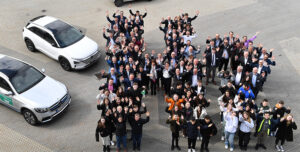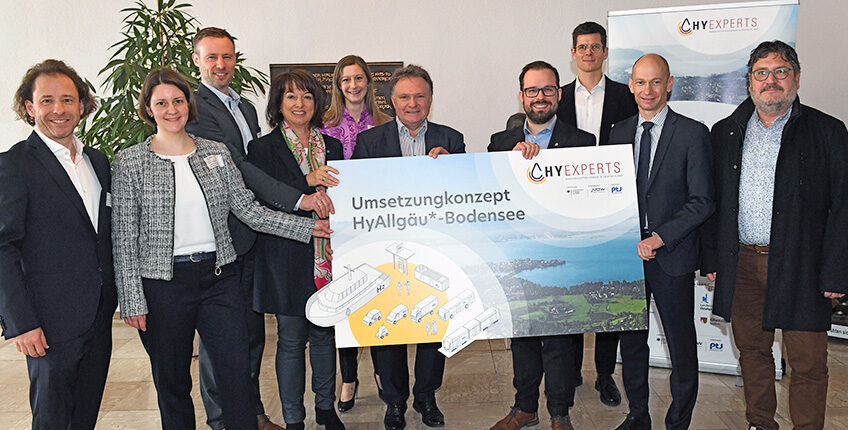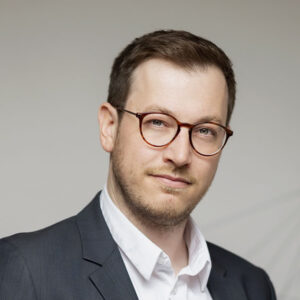Under the leadership of the districts and municipalities, the primary implementation concept for the hydrogen region HyAllgäu*-Bodensee was presented today after almost twelve months of intensive cooperation. More than 120 local stakeholders were involved in the development and many are contributing their own projects.
The high-level final conference also marks the start of further and deeper cooperation throughout the region. The highly concrete roadmap presented will now help projects to be implemented and will in many cases trigger long-term developments. In this way, HyAllgäu*-Bodensee also supports the acquisition of funding for projects in the region.
Hydrogen connects: The energy carrier brings together climate-neutral heating and mobility, enables decarbonisation in small and medium-sized businesses and industry, can be produced locally without emissions, makes us less dependent on energy imports and in this way brings forward completely new perspectives for a regional value chain.
“With the HyAllgäu*-Bodensee implementation concept, we have prepared the foundation on which regional companies and cooperations can build. The questions are where hydrogen will be produced in the future, where it can be refuelled and used over the long term, as well as who can offer which products and services in this context. Access to funding opportunities and local support to take advantage of them should also be optimised on this basis. In short, we have achieved a great deal on which we can now build,” says Elmar Stegmann, District Administrator in the Lindau (Lake Constance) district, who has assumed leadership of the HyAllgäu*-Bodensee project.
A broad approach involving different technologies is being pursued in numerous projects for the production and use of hydrogen in the interconnected region. One focus of the investigation was on electrolysis. In Buchloe, for example, there is potential for the production of green hydrogen from photovoltaics and wind energy. Possible sites for hydrogen production could be established in Buchloe or Lindenberg which could produce green hydrogen for the region. Further options are available in Kempten, for example. Hydrolysis plants making use of sewage sludge as a basis for hydrogen production are also an option for green H2 production in the region. Various supra-regional infrastructure providers specialising in hydrogen have already expressed great interest in using the momentum of the HyAllgäu*-Bodensee region and translating it into further concrete investments. “All this also ensures greater independence from energy imports, tariff regulations and the currently turbulent electricity market,” higlights District Administrator Stegmann.
With regard to the use and provision of hydrogen, four clusters with different focal points of application can be specifically identified, including the operation of hydrogen buses in public transport, the conversion of shipping on Lake Constance to hydrogen operation, the use of hydrogen vehicles by haulage companies and other fleet operators. Planning for the construction of hydrogen filling stations has begun at these locations. Other locations are also being discussed and are potentially interesting for the further expansion of the infrastructure.
“There is high demand for new green solutions, especially in international heavy goods transport. HyAllgäu*-Bodensee provides important impulses in the logistics triangle of Bavaria, Austria and Switzerland to close the chain of hydrogen production, refuelling station and transport. In this way, the project also opens up green perspectives for the bus, construction and waste disposal companies based in the region with their large vehicle fleets,” says District Administrator Stegmann. The focus is always on possible synergies: For example, the hydrogen used for shipping on Lake Constance in the summer could be used in the winter months to generate heat by the Lindau municipal utilities company.
Project network with potential
As a project network with no less than eight regional authorities, HyAllgäu*-Bodensee successfully promotes a wide range of regional interests. More than 100 companies have also looked into the economic and climate protection potential of hydrogen technology under the umbrella of HyAllgäu*-Bodensee. Thanks to this intensive cooperation, interests could be bundled and new perspectives opened up throughout the diverse region. Last but not least, this is reflected in the broad participation of high-ranking representatives from politics, public authorities and business in the final conference. In this way, Lord Mayor Stefan Bosse (City of Kaufbeuren), District Administrator Elmar Stegmann (Lindau District), District Administrator Maria Rita Zinnecker (Ostallgäu District) and District Administrator Alex Eder (Unterallgäu District) discuss the political dimension of the hydrogen region on the ground. Silke Frank (German Hydrogen and Fuel Cell Association – DWV) and Tobias König (National Organisation Hydrogen and Fuel Cell Technology – NOW) contribute the supra-regional perspectives of the network and the funding body. Numerous companies have also sent high-ranking representatives to present their projects and plans. All in all, it becomes impressively clear what high priority is given to the topic of hydrogen in the region.
The development of a regional primary hydrogen concept was funded by the Federal Ministry for Digital and Transport (BMDV – Bundesministerium für Digitales und Verkehr) within the framework of the National Innovation Programme Hydrogen and Fuel Cell Technology (NIP2). NOW, which coordinates the funding programme on behalf of the BMDV, acknowledges the work of the HyAllgäu*-Bodensee project richly. “With the HyExperts region HyAllgäu*-Bodensee, the first participant in the second phase is completing its project. The feasibility studies produced give us blueprints for many other regions facing similar challenges. The project produced interesting results on which generation and utilisation paths could be explored for hydrogen mobility, especially with regard to local shipping. This knowledge forms the basis for the next steps towards implementation in the Lake Constance region,” says Tobias König, Team Leader Cross-Sector Networking, NOW GmbH.
Pioneers continue to be sought – innovation push also in the area of administration
With the presentation of the implementation concept, the hydrogen region remains open for further participants. Furthermore, structures are to be optimised and newly created on the basis of the preliminary work in order to consolidate the existing approaches and to ensure a regional hydrogen economy is developed swiftly.
In addition to the further development of individual project approaches, the deeper networking of projects into so-called H2 clusters is an important step. The coordination of actual H2 needs and their provision in the clusters is a core prerequisite for creating business cases for the stakeholders and should continue to be pursued in a targeted manner. To facilitate vehicle procurement, queries to manufacturers and orders should be bundled and coordinated as far as possible. It is also important to note that funding from the federal government and the state of Bavaria is available for investments in H2 vehicles, refuelling stations and production facilities, and the stakeholders should be supported in accessing this funding. This is particularly applicable to smaller, medium-sized companies investing in their first H2 facilities.
Besides the planning phase as well as delivery and construction times, the approvals for stationary facilities are also essential in order to be able to implement them in a timely manner. This is especially true for the operation of hydrogen production facilities and filling stations. The authorities responsible for approvals (especially district offices) should therefore be involved in project planning and development at an earlier stage. So-called “caretakers” can also simplify and accelerate the processes in the administrations. In this way, hydrogen represents a boost to innovation for the entire region – not just for the local economy but also for its administration.
HyAllgäu*-Bodensee
Under the title “HyAllgäu*-Bodensee”, the project networ is preparing a regionally anchored hydrogen economy in ten regional authorities in Bavaria and Baden-Württemberg, together with further partners. In just under 12 months, the project analysed how a sales market for green hydrogen can be established in the region, which is largely rural with several urban centres, and how short supply chains and efficient processes can contribute to a high level of regional value creation. The analysis focuses on the period 2023-2030 and places an emphasis on mobility and logistics.
The project area encompasses approximately 4,800 km2 with a population of about 800,000. Numerous municipal and private companies from the region, public utilities, energy supply and waste disposal companies, transport and logistics firms and shipping companies as well as universities are part of the project network.
HyAllgäu*-Bodensee, which is under the leadership of the district of Lindau (Lake Constance), builds on the successful HyStarter project “Hydrogen Region Ostallgäu” and forges a bridge to the HyExperts project “HyAllgäu” of the district of Oberallgäu and the city of Kempten, which are affiliated to the current project as associated partners. The comprehensive concept development is funded by the German Federal Ministry for Digital and Transport (BMDV – Bundesministerium für Digitales und Verkehr) within the framework of the National Innovation Programme Hydrogen and Fuel Cell Technology (NIP2) with a total of 400,000 euros.
A consortium consisting of Ludwig-Bölkow-Systemtechnik GmbH (LBST), BBH Consulting AG (BBHC) and motum GmbH was commissioned to develop the concept including a feasibility study.
Project network:
Municipality of Fuchstal – City of Kaufbeuren – City of Konstanz – District of Lindau (Lake Constance), lead – City of Lindau – City of Memmingen – District of Ostallgäu – District of Unterallgäu

Image source: Harald Langer


